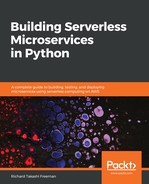Book Description
A practical guide for developing end-to-end serverless microservices in Python for developers, DevOps, and architects.
Key Features
- Create a secure, cost-effective, and scalable serverless data API
- Use identity management and authentication for a user-specific and secure web application
- Go beyond traditional web hosting to explore the full range of cloud hosting options
Book Description
Over the last few years, there has been a massive shift from monolithic architecture to microservices, thanks to their small and independent deployments that allow increased flexibility and agile delivery. Traditionally, virtual machines and containers were the principal mediums for deploying microservices, but they involved a lot of operational effort, configuration, and maintenance. More recently, serverless computing has gained popularity due to its built-in autoscaling abilities, reduced operational costs, and increased productivity.
Building Serverless Microservices in Python begins by introducing you to serverless microservice structures. You will then learn how to create your first serverless data API and test your microservice. Moving on, you'll delve into data management and work with serverless patterns. Finally, the book introduces you to the importance of securing microservices.
By the end of the book, you will have gained the skills you need to combine microservices with serverless computing, making their deployment much easier thanks to the cloud provider managing the servers and capacity planning.
What you will learn
- Discover what microservices offer above and beyond other architectures
- Create a serverless application with AWS
- Gain secure access to data and resources
- Run tests on your configuration and code
- Create a highly available serverless microservice data API
- Build, deploy, and run your serverless configuration and code
Who this book is for
If you are a developer with basic knowledge of Python and want to learn how to build, test, deploy, and secure microservices, then this book is for you. No prior knowledge of building microservices is required.
